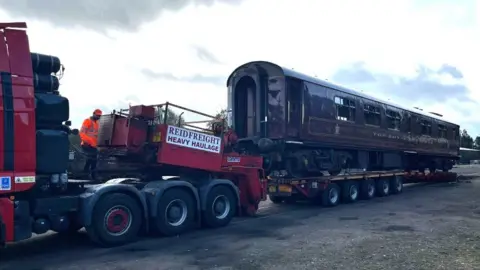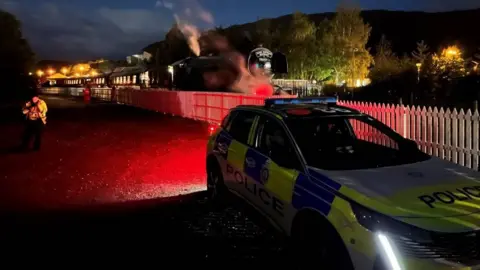Investigators reviewing Flying Scotsman collision
 BBC
BBCInvestigators are reviewing a low-speed crash involving the world-famous Flying Scotsman locomotive.
Two people were treated in hospital following the collision with a Royal Scotsman train at Aviemore Station in the Highlands on Friday.
The Rail Accident Investigation Branch (RAIB) said it had been informed of the accident.
A spokeswoman said investigators were looking at available evidence and deciding what further action to take.
Police Scotland said it had concluded its inquiries, and had found there was no criminality involved.
The Flying Scotsman had been scheduled to be running passenger trips over the weekend, but was withdrawn from service for safety checks.
On Monday morning, a carriage from the Royal Scotsman train was seen being loaded on to a lorry.
The National Railway Museum, which owns Flying Scotsman, described Friday's accident as a "shunting incident" involving its locomotive and the Royal Scotsman train carriages.
The museum said immediate action was taken to alert emergency services.
A man and a woman were taken to Raigmore Hospital in Inverness following the crash, but were later released after treatment for minor injuries.
A number of people were also assessed at the scene but did not require treatment.

The National Railway Museum said: "The museum's aim is to understand what happened and to determine if there is any damage to Flying Scotsman as its owner."We will make further announcements about Flying Scotsman's operating calendar and future dates, once investigations are complete. "The National Railway Museum wishes to thank the emergency services who attended the scene on Friday for their prompt response and to the staff and crew of the Strathspey Railway and the Royal Scotsman train."
At the time of the accident, the carriages were stationary on a private line owned by Strathspey Railway. The charity has been able to resume its operations.

The newly-restored Flying Scotsman was unveiled last year ahead of a series of events to celebrate its centenary.
The 97-tonne locomotive was built in Doncaster in 1923, and is now owned by the National Railway Museum in York.
The steam locomotive was the first in the UK to officially reach 100mph, and was the first-ever service to run non-stop from London to Edinburgh.
While it is owned and operated by the National Railway Museum it is maintained by Riley & Son (E) Ltd, based in Heywood, Greater Manchester.
As part of its centenary year, the locomotive is visiting railway stations around the UK and has spent time at the National Railway Museum.
